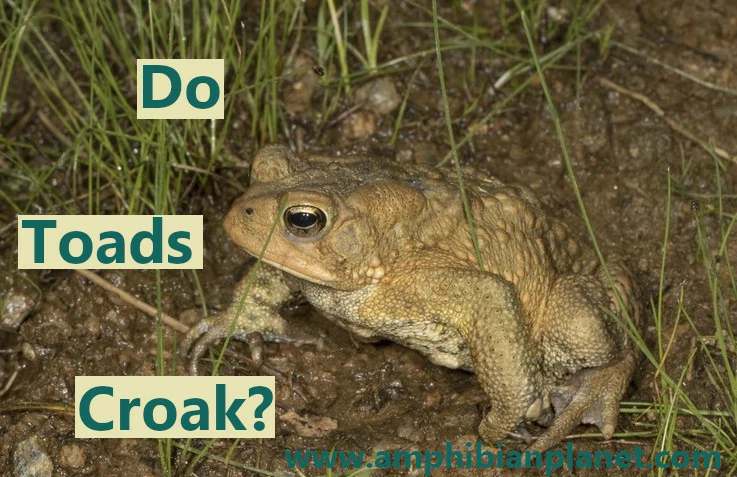Croaking is one of the most common noises frogs make. Frogs and toads have many things in common, so you may be wondering if toads croak too.
Like frogs, toads croak to attract females of the same species to mate with. A few common toad advertisement calls are a high-pitched melodic trill, a rapid chirping, a high-pitched repeated “peep”, a loud, nasal “waaah,” a low-pitched whistling screech, and high-pitched, rough “qwark-qwark”.
Every toad species has a sound that is unique to their species – and the calls of some species can be heard over a mile away!
How Do Toads Croak?
Toads have simple vocal cords that have two slits in the bottom of the mouth. They also have a vocal sac that can amplify the vibrations from the vocal cords.
When calling, a toad closes its mouth and nostrils, and expels air from its lungs through the vocal cords and into the vocal sacs. The vibrations of the vocal cords emit a sound – and the inflating and deflating vocal sac makes the sound louder or quieter.
By forcing air back and forth between their vocal sac and their lungs, the call becomes rhythmical.
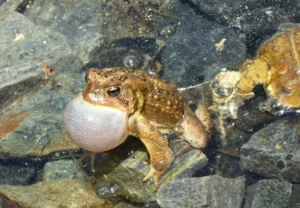
The vocal sac is an elastic membrane of skin. It acts as a resonating chamber, causing the male toads’ mating call to be amplified and carried significant distances.
Most toads have a single vocal sac under their throat, whereas other toads have the vocal sac on the corner of their mouth.
When a toad calls, the vocal sac will expand, but its mouth won’t open. Sometimes, it may look like the toad is staring off while making the sound.
A male toad can croak individually, or a group of males may croak together in a chorus.
The Mating Calls of 12 Toad Species
As earlier mentioned, each species of toad has its own sounds can calls.
For example, the call of the American toad is a long, high-pitched, musical trill, often lasting up to half a minute.
On the other hand, the oak toad’s call is a high-pitched, continuously repeated “peep!”, that is often compared to the vocalizations of young chickens.
Here are the mating calls of 12 toad species:
1. American Toad (Anaxyrus americanus)

American toads are found throughout much of the eastern United States and Canada.
The male’s call is a long, high-pitched, musical trill, lasting 6–30 seconds.
When calling in a chorus, each male calls at a slightly different pitch, and individuals may alternate and overlap calls.
2. Fowler’s Toad (Anaxyrus fowleri)
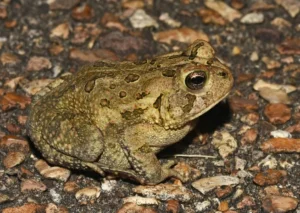
Fowler’s toads are found throughout much of the eastern United States and parts of southeastern Canada.
The males call is a short, medium-pitched, raspy, nasal “w-a-a-a-a-a-h,” lasting from 1 to 3 seconds – and is often compared to the sound of a crying baby
Fowler’s Toads often interbreed with American toads, and the calls of the hybrids are in between those of the parent species.
3. Western Toad (Anaxyrus boreas)
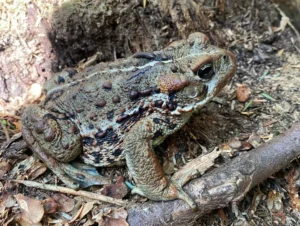
Western Toads are found west of the Rocky Mountains, from Mexico to southern Alaska.
The male’s call is a high-pitched plinking sound, like the peeping of a chick, repeated several times.
These calls are produced with notes in rapid succession, and the sound of a group of males calling has been compared to the sound of a distant flock of geese.
Western toads’ mating calls are not very loud, and one must be relatively close to hear them.
4. Southern Toad (Anaxyrus terrestris)

Southern toads are found from southeastern Virginia to Florida and eastern Louisiana. There is also an isolated colony in northwestern South Carolina.
The male’s call is a long trill resembling that of American toads but usually shorter in duration (about 2 to 8 seconds), and slightly higher in pitch.
5. Cane Toad (Rhinella marina)
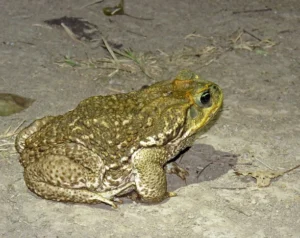
Cane toads (also called marine toads) are native to South and Central America. But they have also been introduced to other countries where they aren’t native, such as Australia, where they have become a significant pest species.
They are also found in areas of Central and South Florida, including Key West and Stock Island, and in an isolated population in Bay County in the panhandle.
The mating call of male cane toads is a slow, melodic trill.
6. Colorado River Toad (Incilius alvarius)

Colorado River toads (also called Sonoran desert toads) are found in and around the Sonoran Desert in California and Arizona south to Mexico.
The male’s call is a weak, low-pitched whistling screech, about 1/2 – 1 second in duration – that is sometimes compared to a ferryboat whistle.
Colorado River toads have a reduced vocal sac and their calls can not be heard far away.
7. European Green Toad (Bufotes viridis)

European green toads are found in mainland Europe, from far eastern France and Denmark to the Balkans and Western Russia.
The male’s call is a high-pitched, melodic trill.
8. Natterjack Toad (Epidalea calamita)

Natterjack toads are found in parts of Western Europe.
The male’s call is a loud ‘errr..errr..errr’. This call be heard from up to can be heard from up to 1.2 miles (2km) away on quiet nights.
9. Oak Toad (Anaxyrus quercicus)

Oak toads are found in the coastal regions of the southeastern United States, from eastern Louisiana to southeast Virginia and south throughout Florida.
The male’s call is a high-pitched, continuous “cheep-cheep-cheep”, sometimes compared to the sound of a hatchling chick.
10. Woodhouse’s Toad (Anaxyrus woodhousii)

Woodhouse’s toads are found throughout much of the central and western United States.
The male’s call is a loud, nasal “w-a-a-a-ah” lasting about 1-1 1/2 seconds – that is often described as sounding like the bleat of a sheep.
11. Red-spotted toad (Anaxyrus punctatus)

Red-spotted toads are found from southern Nevada to southwestern Kansas, south to Hidalgo, Mexico, and throughout Baja California.
The male’s call is a loud high-pitched musical trill, lasting up to 10 seconds. The call is sometimes compared to the sound of a cricket.
12. Eastern Spadefoot Toad (Scaphiopus holbrookii)

Eastern spadefoot toads are found in the United States, from southern New England through the Florida Keys, west to central Louisiana, north to southern Illinois, and Ohio.
The male’s call is a single, short, and low-pitched, “Whar”, that is sometimes compared to the sound of a crow or bleating sheep.
In large choruses, the sound can be very loud.
Why Do Toads Croak?
The main reason toads croak is to attract mates. The loud croaking comes from male toads trying to attract the attention of females with whom to mate.
Males usually call from ponds, swamps, streams, and other possible breeding sites. Since each toad has a unique mating call, females will only be attracted to the call of their own species.
Oftentimes, males will call, even if they don’t see or hear any females nearby.
When females are ready to mate, they will move towards calling males, and pick the male that they prefer.
The sound of calling toads is most common in the mating season, which is usually warm spring or summer months, after heavy rain.
The mating calls usually intensify at night due to cooler temperatures, higher humidity, and fewer predators.
The darkness of the night means calling toads are less vulnerable to predators such as hawks, or eagles that are active during the day.
Toads also blend into their environments easier to hide and avoid active predators in the cover that the darkness provides.
Sometimes, Toads Croak to Defend Their Territory
In the mating season, male toads often form temporary territories to attract females, which they defend from other males. These territories usually occupy the immediate area around an individual.
Breeding male toads will defend the boundaries of their territories, and scare off other males by using a variety of calls. Some toads will even fight intruding males.
Research has shown that male frogs/toads of many species can tell the difference between their established neighbors, and unfamiliar strangers. This helps them avoid aggressive encounters with male frogs that hold territory nearby.
Female toads choose their mates by the quality of their call, and their ability to defend their territory.
Other Toad Vocalizations
Territorial calls and mating calls are often classed as “advertisement calls”, letting other toads know that they are present.
However, toads can make a variety of other sounds, for different functions.
Many toad species can make “distress calls” when they are grasped by a predator. This call is usually a high-pitched scream that startles a predator causing it to release the toad, enabling the toad to escape.
Another type of vocalization is made by toads that have been unwillingly grabbed by another toad searching for a mate, these are known as release calls.
When a male toad is try to mate, he may attempt to grab onto any toad or frog that is close to him. If he grabs onto another male toad, a female that has already mated, or a toad of a different species, the grabbed toad will emit a release call – telling the offending male to let go.
The sound of the release call can be different depending on the toad species. In American toads, the release call is a repeated chirp, accompanied by abdominal vibrations.
Another vocalization in some toad species is a “warning call”, a noise that is made by a toad that has been startled or disturbed. The toad may make a short grunt or squawk, to let other toads know there is danger.
Do Female Toads Croak?
Female frogs and toads are generally considered to be the quieter sex since they generally lack or have reduced vocal cords.
In almost all species, only the male will make mating or territorial calls. However, both males and females are capable of making release, distress, or warning calls.
Sources:
Gerhardt, H. C. (1994). The Evolution of Vocalization in Frogs and Toads. Annual Review of Ecology and Systematics, 25, 293–324. http://www.jstor.org/stable/2097314
Emerson SB, Boyd SK. Mating vocalizations of female frogs: control and evolutionary mechanisms. Brain Behav Evol. 1999;53(4):187-97. doi: 10.1159/000006594. PMID: 10343085.
Zhang F, Zhao J, Feng AS. Vocalizations of female frogs contain nonlinear characteristics and individual signatures. PLoS One. 2017 Mar 30;12(3):e0174815. doi: 10.1371/journal.pone.0174815. PMID: 28358859; PMCID: PMC5373630.
Walkowiak, W. (2007). Call Production and Neural Basis of Vocalization. In: Narins, P.M., Feng, A.S., Fay, R.R., Popper, A.N. (eds) Hearing and Sound Communication in Amphibians. Springer Handbook of Auditory Research, vol 28. Springer, New York, NY. https://doi.org/10.1007/978-0-387-47796-1_4
Gerhardt, H.C. Sound pressure levels and radiation patterns of the vocalizations of some North American frogs and toads. J. Comp. Physiol. 102, 1–12 (1975). https://doi.org/10.1007/BF00657481
Iris Starnberger, Doris Preininger, Walter Hödl, The anuran vocal sac: a tool for multimodal signaling, Animal Behaviour, Volume 97,2014, Pages 281-288, ISSN 0003-3472, https://doi.org/10.1016/j.anbehav.2014.07.027.

